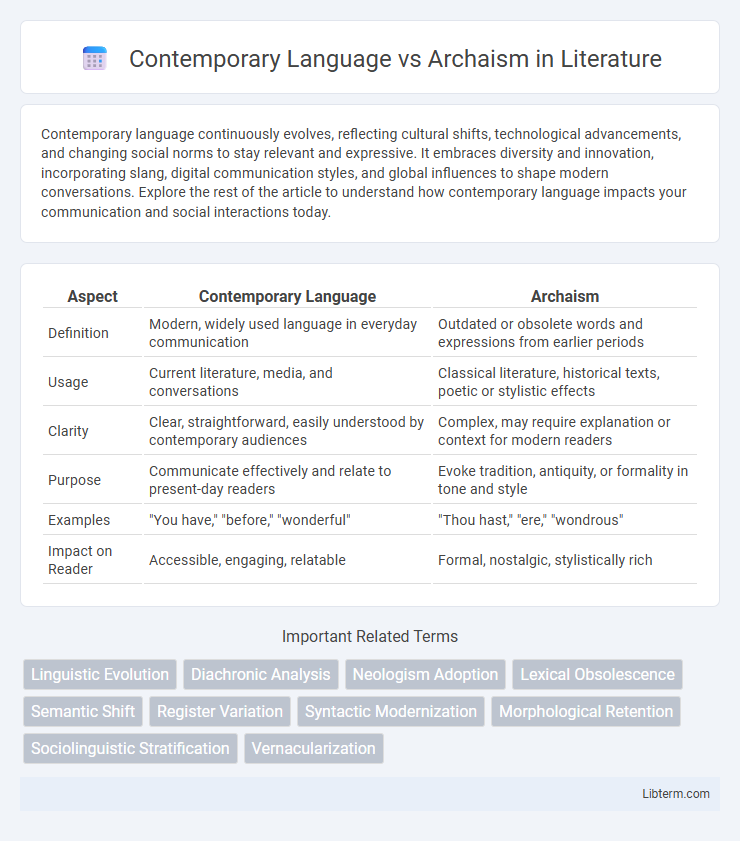Contemporary language continuously evolves, reflecting cultural shifts, technological advancements, and changing social norms to stay relevant and expressive. It embraces diversity and innovation, incorporating slang, digital communication styles, and global influences to shape modern conversations. Explore the rest of the article to understand how contemporary language impacts your communication and social interactions today.
Table of Comparison
| Aspect | Contemporary Language | Archaism |
|---|---|---|
| Definition | Modern, widely used language in everyday communication | Outdated or obsolete words and expressions from earlier periods |
| Usage | Current literature, media, and conversations | Classical literature, historical texts, poetic or stylistic effects |
| Clarity | Clear, straightforward, easily understood by contemporary audiences | Complex, may require explanation or context for modern readers |
| Purpose | Communicate effectively and relate to present-day readers | Evoke tradition, antiquity, or formality in tone and style |
| Examples | "You have," "before," "wonderful" | "Thou hast," "ere," "wondrous" |
| Impact on Reader | Accessible, engaging, relatable | Formal, nostalgic, stylistically rich |
Understanding Contemporary Language
Contemporary language reflects current usage, evolving through technology, culture, and social interaction, making it essential for effective communication today. Its vocabulary, grammar, and idioms adapt rapidly to trends, digital media, and multicultural influences, ensuring relevance and clarity in modern contexts. Understanding contemporary language enhances comprehension in educational settings, professional environments, and everyday conversations, bridging generational and cultural gaps.
Defining Archaism in Linguistics
Archaism in linguistics refers to words, phrases, or grammatical structures that were once common in a language but have become obsolete or rare in contemporary usage. These linguistic elements often appear in historical texts or poetry to evoke a sense of antiquity or tradition. Understanding archaism helps linguists trace language evolution and cultural shifts within societies.
Historical Evolution of Language
Contemporary language reflects the dynamic evolution of vocabulary, syntax, and pronunciation shaped by cultural shifts, technological advancements, and globalization. Archaism preserves linguistic elements from earlier historical stages, serving as a window into the language's original forms and its transformation over centuries. The historical evolution of language illustrates the gradual transition from archaic terms and structures to modern usage, highlighting the influence of social, political, and technological factors on linguistic change.
Key Differences Between Contemporary Language and Archaisms
Contemporary language features vocabulary and grammar that reflect current usage, ease of understanding, and evolving cultural contexts, whereas archaisms consist of outdated words and phrases largely obsolete in modern communication but retained for stylistic or historical emphasis. Contemporary language emphasizes clarity and efficiency, driven by technological advances and global connectivity, contrasting with archaisms' richness in representing historical identity and linguistic heritage. The key differences lie in their frequency of use, relevance to present-day contexts, and cognitive accessibility for modern audiences.
The Role of Archaisms in Modern Communication
Archaisms in modern communication serve as powerful linguistic tools that evoke tradition, authenticity, and cultural heritage, enriching contemporary language by connecting speakers to historical contexts. They often appear in literature, legal language, and ceremonial speech, where their presence enhances solemnity and authority. Despite their rarity in everyday conversation, archaisms contribute to stylistic diversity and can emphasize particular meanings or sentiments that contemporary terms may lack.
Impact of Technology on Language Change
Contemporary language evolves rapidly influenced by digital communication platforms, where technology introduces new vocabulary, abbreviations, and syntax reflective of online culture. Archaisms, by contrast, serve as linguistic time capsules, preserving historical language forms rarely used outside academic or literary contexts. The impact of technology accelerates language change by promoting immediacy and efficiency, often rendering archaic expressions obsolete in everyday use while fostering the continuous creation of neologisms.
Archaisms in Literature and Arts
Archaisms in literature and arts serve as powerful tools to evoke historical authenticity, enrich thematic depth, and create stylistic contrast within contemporary works. These antiquated words and expressions often highlight cultural heritage, emphasizing the distinct evolution of language and artistic expression over time. Writers and artists employ archaisms to immerse audiences in specific eras, enhancing narrative atmosphere and emotional resonance by bridging past and present linguistic forms.
Practical Uses of Contemporary Language
Contemporary language prioritizes clarity, efficiency, and adaptability, making it essential for modern communication across technology, business, and everyday interactions. It enhances accessibility and understanding by utilizing current vocabulary, idiomatic expressions, and simplified grammar, which are preferred in media, education, and digital platforms. This practical use contrasts with archaism, which is often reserved for stylistic, historical, or literary contexts to evoke a sense of tradition or formality.
Preservation and Revival of Archaic Terms
Preservation and revival of archaic terms play a crucial role in enriching contemporary language by maintaining historical depth and cultural heritage. Linguistic scholars and cultural institutions often document and reintroduce archaic vocabulary through literature, educational curricula, and media, ensuring these words remain accessible and relevant. This process fosters a dynamic interplay between modern speech and historical expression, enhancing semantic diversity and linguistic appreciation.
The Future of Language: Trends and Predictions
Contemporary language evolves rapidly through digital communication, incorporating slang, emojis, and new syntactic structures influenced by social media platforms. Archaism, while preserved in literature and formal settings, gradually diminishes in everyday use but remains valuable for historical and cultural studies. Linguists predict that the future of language will blend innovative expressions with selective archaisms, fostering dynamic linguistic diversity shaped by technology and globalization.
Contemporary Language Infographic

 libterm.com
libterm.com